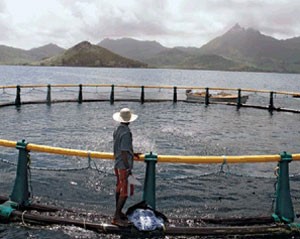Aquaculture is the cultivating and harvesting of aquatic (freshwater and marine) animals and plants in controlled systems for commercial, recreation or resource management purposes.
Aquaculture for food production involves interventions like regular stocking, the caring for, feeding and protection from predators of these aquatic species in the rearing process with the intention of increasing their quantity and value.
Efforts to locate and capture wild stock supplies are also reduced and customers are ensured of a more orderly and timely supply of specific stock of high quality. Aquaculture is now recognised worldwide as a viable and profitable enterprise which will continue to grow and supply an increasing percentage of fishery products, because the fresh water dams, rivers and oceans are inadequately managed and their yield is unpredictable.
Aquaculture in South Africa includes the farming of fish, molluscs, crustaceans, water plants, some reptiles and amphibians. It started out as a small source of additional food but has since become one of the major food producers. Although aquaculture in South Africa has a very long history, it never made a big impact, however today it is one of the fastest growing sectors in Agriculture.
Production systems
In planning an aquaculture production enterprise the choice of production system is critical as the system will affect the profitable and stability of the enterprise.
Depending on marketing strategy and information and the availability of resources (water and land), the following production system can be implemented.

Extensive: This form of fish farming is applied in large dams or lakes. Fish populations in these dams or lakes occurred by natural growth or migration without human aid. The availability and amount of food for these fish populations largely depends on the natural fertility of the waters. These waters cannot be drained easily, and only a small fraction of the existing fish population can be caught annually. The total number of fish in these waters is not known. The relation between the different species and the ages of the fish is also not known. The fish farming activity is confined only to catching fish.
Semi-intensive: This type of farming is possible in medium-size dams and some river weirs. Although complete control over factors influencing fish production in these waters cannot be achieved, certain improvements are possible which can help increase yields. These improvements include stocking with suitable species, preparing fishing sites, and fertilising the water, among other things.




















